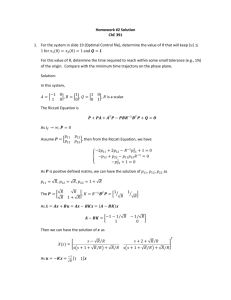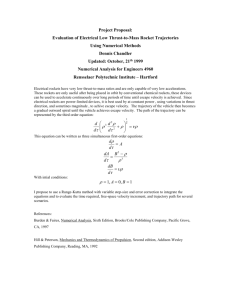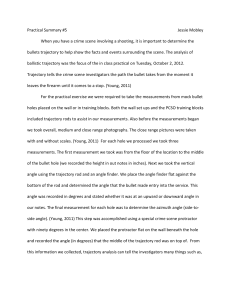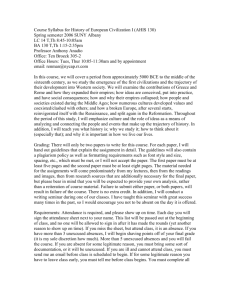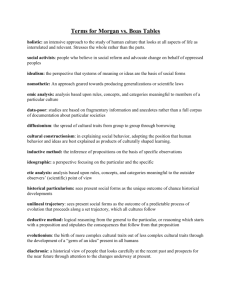GRIB template for 4-D Trajectory grid definition
advertisement
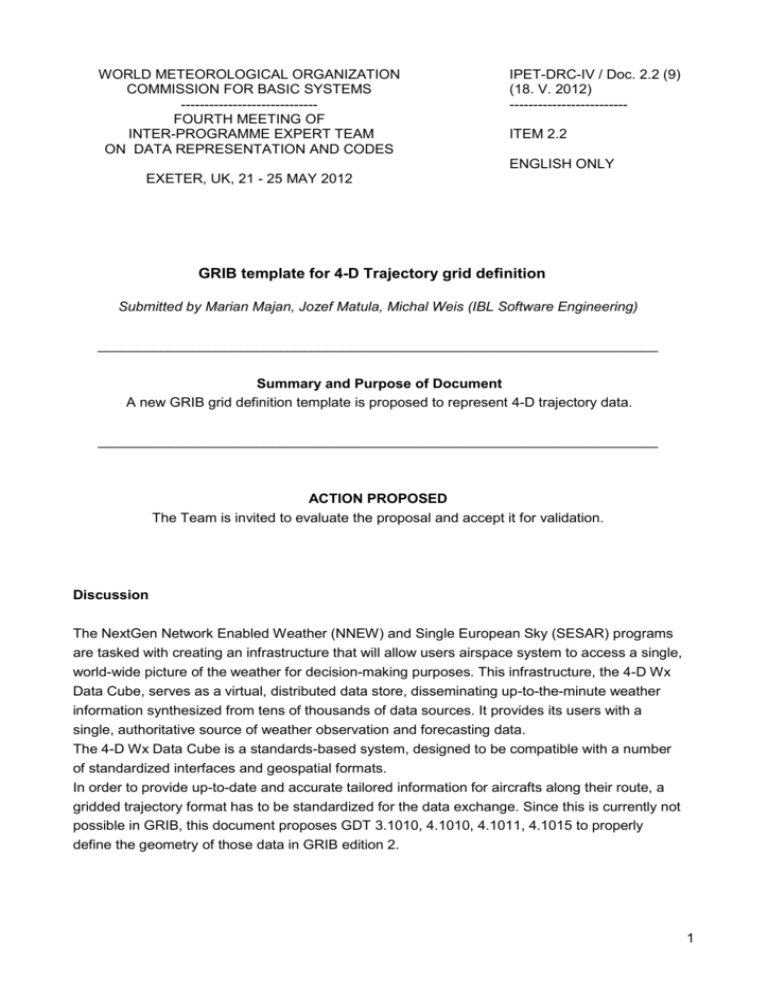
WORLD METEOROLOGICAL ORGANIZATION COMMISSION FOR BASIC SYSTEMS ----------------------------FOURTH MEETING OF INTER-PROGRAMME EXPERT TEAM ON DATA REPRESENTATION AND CODES IPET-DRC-IV / Doc. 2.2 (9) (18. V. 2012) ------------------------ITEM 2.2 ENGLISH ONLY EXETER, UK, 21 - 25 MAY 2012 GRIB template for 4-D Trajectory grid definition Submitted by Marian Majan, Jozef Matula, Michal Weis (IBL Software Engineering) _______________________________________________________________________ Summary and Purpose of Document A new GRIB grid definition template is proposed to represent 4-D trajectory data. _______________________________________________________________________ ACTION PROPOSED The Team is invited to evaluate the proposal and accept it for validation. Discussion The NextGen Network Enabled Weather (NNEW) and Single European Sky (SESAR) programs are tasked with creating an infrastructure that will allow users airspace system to access a single, world-wide picture of the weather for decision-making purposes. This infrastructure, the 4-D Wx Data Cube, serves as a virtual, distributed data store, disseminating up-to-the-minute weather information synthesized from tens of thousands of data sources. It provides its users with a single, authoritative source of weather observation and forecasting data. The 4-D Wx Data Cube is a standards-based system, designed to be compatible with a number of standardized interfaces and geospatial formats. In order to provide up-to-date and accurate tailored information for aircrafts along their route, a gridded trajectory format has to be standardized for the data exchange. Since this is currently not possible in GRIB, this document proposes GDT 3.1010, 4.1010, 4.1011, 4.1015 to properly define the geometry of those data in GRIB edition 2. 1 Figure 1: A 4-D (temporal) trajectory with four waypoints [Bra10] Figure 2: A gridded representation of trajectory values with four waypoints (with slices size 8x8 grid points) [Bra10] PROPOSAL The following GDTs are proposed to represent the 4-D Trajectory grid definition in GRIB 2. New templates Template 3.1010 – 4-D Trajectory grid definition. Octet No. Contents 15 Shape of the Earth (see Code table 3.2) 16 Scale factor of radius of spherical Earth 17–20 Scaled value of radius of spherical Earth 21 Scale factor of major axis of oblate spheroid Earth 22–25 Scaled value of major axis of oblate spheroid Earth 2 26 27–30 31–32 33–34 35–38 39–42 43–46 47–50 51 52–53 54–(53+NW×24) Scale factor of minor axis of oblate spheroid Earth Scaled value of minor axis of oblate spheroid Earth Number of horizontal points in slice (see Note 1) Number of vertical points in slice (see Note 1) Di – slice horizontal grid length (see Note 2) Dj – slice vertical grid length (see Note 2) Pi – horizontal location of trajectory point within slice (see Note 3) Pj – vertical location of trajectory point within slice (see Note 3) Scanning mode (flags – see Flag table 3.4) (see Note 1) NW – Number of way points (see Note 4) Waypoint descriptions to define 4-D coordinates Waypoint descriptions: 30+(N×24+0–N×24+3) 30+(N×24+4–N×24+7) 30+(N×24+8) LaN – latitude of Nth trajectory way point LoN – longitude of Nth trajectory way point Type of Nth’s trajectory way point surface (see Code table 4.5) (see Note 5) 30+(N×24+9) Scale factor of Nth’s trajectory way point surface 30+(N×24+10–N×24+13) Scaled value of Nth’s trajectory way point surface 30+(N×24+14) Indicator of unit of time range (see Code table 4.4) 30+(N×24+15–N×24+18) Waypoint time in units defined by octet N×24+14 (see Note 6) 30+(N×24+19–N×24+22) Number of slices per trajectory segment (see Note 7) 30+(N×24+23) Number of additional leading and trailing slices (see Note 8) Notes: (1) Horizontal and vertical points in slice indicate orthogonal grid slice perpendicular to point along the trajectory segment. Therefore scanning mode describes scanning within single slice. (2) Grid lengths are in units of 10–3 m. Trajectory is always positioned in the centre of the slice. (3) Location of trajectory point within slice is in units of 10–3 m relative from first grid point of this slice. (4) Type of line for way segments is assumed to be Great Circle. (5) Each of waypoints can be in different types of surface coordinates. For the purpose of light transition level, point of transition can be repeated in both meters above surface and isobaric level equivalent to height reduction based on QNH valid for FIR at that moment. Waypoint can be also repeated for stopover on the trajectory with same 3-D coordinates but different waypoint time. First point of transition level or stopover description can have MISSING slices in this case. (6) Waypoint time is relative to reference time of data defined in Section 1. (7) Slices are defined as perpendicular planes which are equidistantly spaced along the trajectory segment. First slice is always located in first point of trajectory segment and last slice in last point of trajectory segment. Therefore minimum number of slices is 2, unless set to MISSING (for last point of trajectory or for transition level repeated point). 3 Figure 3: Example of trajectory segment with 5 slices (circles represent trajectory waypoints) (8) Number of leading slices is same as number of trailing slices, and represents additional slices outside the trajectory segment but within its direction using same equidistant spacing as for corresponding trajectory segment itself. Figure 4: Example of trajectory segment with 5 slices and 1 leading and trailing slice (circles represent trajectory waypoints) (9) A scaled value of radius of spherical Earth, or major or minor axis of oblate spheriod Earth, is derived by applying the appropriate scale factor to the value expressed in metres. Product definition template 4.1010 – 4-D trajectory Octet No. Contents 10 Parameter category (see Code table 4.1) 11 Parameter number (see Code table 4.2) 12 Type of generating process (see Code table 4.3) 13 Background generating process identifier (defined by originating centre) 14 Analysis or forecast generating process identifier (defined by originating centre) 15–16 Hours of observational data cutoff after reference time (see Note) 17 Minutes of observational data cutoff after reference time Note: Hours greater than 65534 will be coded as 65534. Product definition template 4.1011 – 4-D trajectory ensemble forecast, control and perturbed Octet No. Contents 10 Parameter category (see Code table 4.1) 11 Parameter number (see Code table 4.2) 12 Type of generating process (see Code table 4.3) 13 Background generating process identifier (defined by originating Centre) 14 Forecast generating process identifier (defined by originating Centre) 15–16 Hours after reference time of data cutoff (see Note) 17 Minutes after reference time of data cutoff 18 Type of ensemble forecast (see Code table 4.6) 19 Perturbation number 20 Number of forecasts in ensemble Note: Hours greater than 65534 will be coded as 65534. 4 Product definition template 4.1015 – 4-D trajectory probability forecasts Octet No. Contents 10 Parameter category (see Code table 4.1) 11 Parameter number (see Code table 4.2) 12 Type of generating process (see Code table 4.3) 13 Background generating process identifier (defined by originating centre) 14 Forecast generating process identifier (defined by originating centre) 15–16 Hours after reference time of data cutoff (see Note) 17 Minutes after reference time of data cutoff 18 Forecast probability number 19 Total number of forecast probabilities 20 Probability type (see Code table 4.9) 21 Scale factor of lower limit 22–25 Scaled value of lower limit 26 Scale factor of upper limit 27–30 Scaled value of upper limit Note: Hours greater than 65534 will be coded as 65534. References [Bra10] BRAECKEL, A., WEINGRUBER, R.: 4-Dimensional Weather Data Cube (Web Coverage Service (WCS) 1.1.2 Interface Extensions). Version 1.0. National Center for Atmospheric Research. 2010. 5



